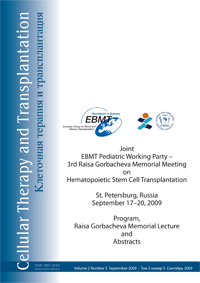Comparison of MRD data assessed by flow cytometry and RT-PCR of fusion gene transcripts in infants with MLL-rearranged ALL
Alexander M. Popov1,2,3, Grigory A. Tsaur1,2, Anna S. Ivanova1,2, Yulia A. Yakovleva1,2, Tatiana Y. Verzhbitskaya1,2, Tatiana O. Riger1, Egor V. Shorikov1,2, Leonid I. Savelyev1,2,3, Larisa G. Fechina1,2
1Pediatric Oncology and Hematology Center, Regional Children’s Hospital, Ekaterinburg, Russia; 2Research Institute of Medical Cell Technologies, Ekaterinburg, Russia; 3Ural State Medical Academy, Ekaterinburg, Russia
Correspondence
Alexander M. Popov, Regional Children’s Hospital, Pediatric Oncology & Hematology Center, S. Deryabina Street 32, 620149 Ekaterinburg, Russia, Phone: +7 (908) 9037736, Fax: +7 (343) 2162517
E-mail: uralflow@gmail.com
Summary
Aim
To evaluate qualitative and quantitative concordance between MRD data assessed by flow cytometry (FC) and fusion gene transcript (FGt) copy number (CN) measured by real-time quantitative PCR (RQ-PCR) in infants with primary and relapsed MLL-rearranged ALL during treatment.
Methods
A tandem application of multicolor FC for MRD detection and RQ-PCR for FGt CN was performed in 72 follow-up bone marrow samples from 15 infants with MLL-rearranged B-lineage ALL. Twenty samples were obtained during remission induction, 36 during postinduction, and 16 during relapse treatment.
Results
Of the 72 samples, 7 (9.72%) were MRD-negative by both methods, while 2 (2.78%) were negative by FC but positive by RQ-PCR. The remaining 63 samples (87.50%) were MRD-positive by both methods. High qualitative concordance (97.22%) between FC and RQ-PCR was obtained. In contrast, low quantitative concordance was found (r=0.54). The significant quantitative difference in FC and RQ-PCR data could be associated with variability of FG expression during treatment that does not correspond to the cell number. Moreover, during FC the MRD detection percentage of tumor blasts among all nucleated cells is calculated, while the MRD value in RQ-PCR of FGt corresponds to the initial FGt and control gene levels. FC appears to be better for a quantitative MRD assessment; however FGt detection in RQ-PCR is more appropriate for MRD qualitative analysis because of its higher sensitivity. Hence, FC is more applicable for early treatment stratification and RQ-PCR of FGt for later time points.
Conclusion
A tandem application of FC at early time points and FGt detection by RQ-PCR at later time points seems to be a useful tool for MRD monitoring in infants with MLL rearranged ALL.
Keywords
MRD, MLL, infants, flow cytometry, fusion gene transcript


